In the late 1980s to mid-1990s, Eugène Delacroix`s wall painting "Jacob Wrestling with the Angel" at San Sulpice in Paris became a symbolic and iconic painting for me, a prism that reflected East and West dynamics. This exploration turned to obsession. However, before I delved into this painting and many others by Delacroix, I was a student of Edward Said in my approach; a visual inquiry that paralleled Said’s literary one. Said’s Orientalism, The Question of Palestine and After the Last Sky propelled me to search for historical themes in European paintings and drawings–-and not just Orientalist subjects, but also how Europeans portrayed themselves.
Initially, the subject matter I was looking for was vague. My search was broad. I scanned the decorative styles and patterns, in the frames, dress and drapery fabrics. In David, it was the women’s hair and satin dresses, the carvings in the furniture or the draped windows. I looked at Fragonard, Gerome, and Matisse, as well as a variety of British artists before I settled on Eugène Delacroix—whose paintings and drawings seemed to be the most complex in how they balanced empathy with stereotypes of the Middle East.
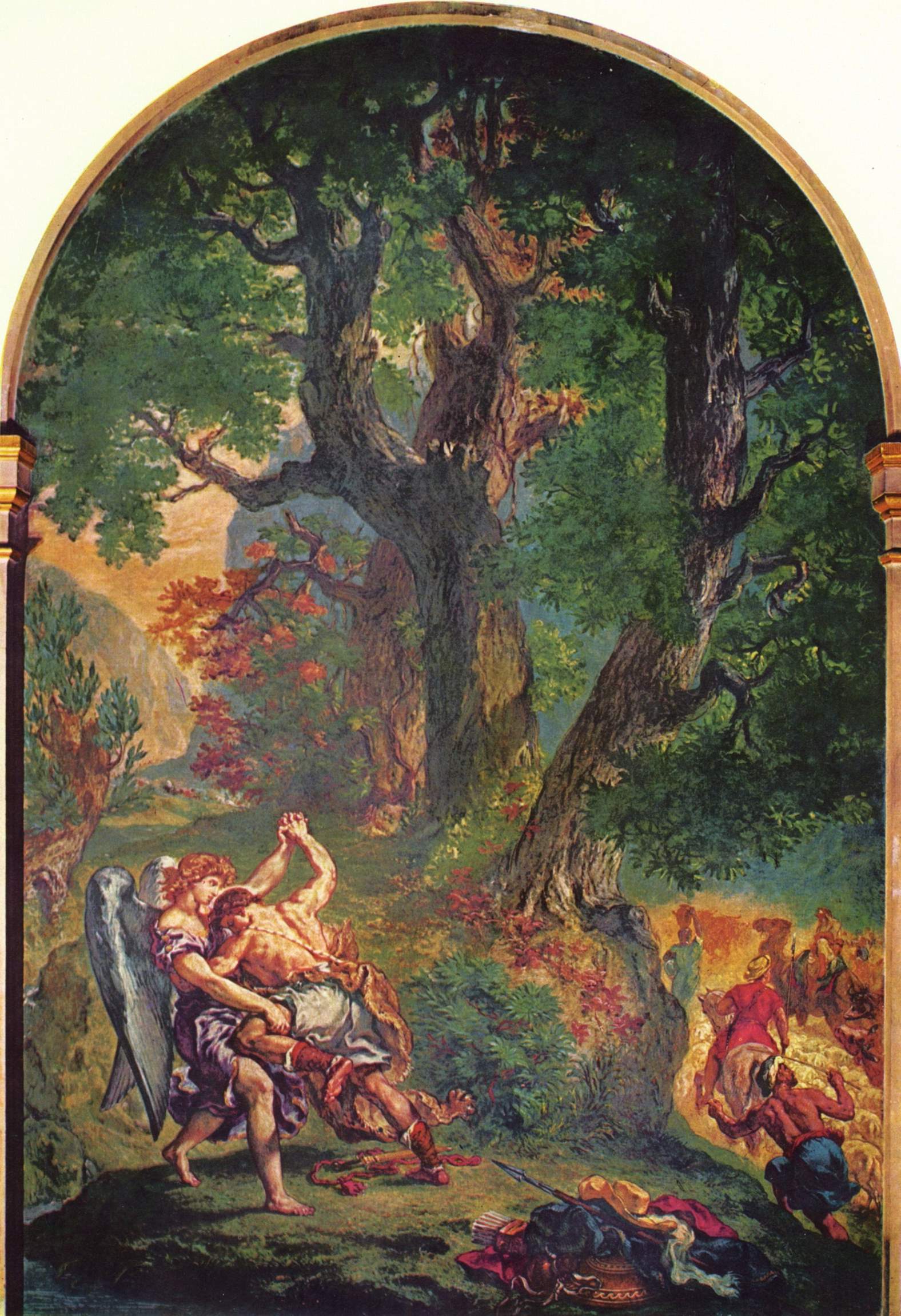 [Eugene Delacroix, Jacob Wrestling the Angel" (1861). Imave via Wikimedia Commons.]
[Eugene Delacroix, Jacob Wrestling the Angel" (1861). Imave via Wikimedia Commons.]
I was focused on “Jacob Wrestling with the Angel” as though I was analyzing forensic residues. I zeroed in on the angel’s golden curly hair, his flowing robe and feathery wings. I analyzed how the Arab-like characters in the painting were positioned. His men were Arabs; dark and in striped turbans and they were abandoning him as Delacroix’s journals describe. These men were turning away from the scene of Jacob’s struggle. Ironically, Jacob was dressed more as a European. He was fairer, did not wear a turban and was more clothed, albeit with crude animal skins. His hat looked like that of a European farmer or artist as his sack seemed to be full of quivers, though I like to think they were paint brushes. He had more in common with a European man than those other men that were supposedly his men--their loyalty jealously questioned. I thought it best to make a “correction” of the disassociation from Jacob.
 [Doris Bittar, "Open Your Eyes Under The Oblivious Sun of The West " (1991). Image copyright the artist.]
[Doris Bittar, "Open Your Eyes Under The Oblivious Sun of The West " (1991). Image copyright the artist.]
This narrative was an affront because it mimed the first Gulf War in Iraq; it had the same contempt for the Arab. It demonstrates the roots of what we now call Neo-cons. It was the beginning of a twenty-year slaughter of the Iraqi people, during which nearly a million were killed from war and sanctions. I decided to take apart/deconstruct the narrative and then reassemble it. I changed the scale of the Arab, making him much bigger and placing him in the center of the recomposed arena. Though the Arab was now in the center and looking at the scene of Jacob and the angel, it was clear that the attention remained on Jacob and the Angel’s embrace-struggle-dance. It had more grist and force.
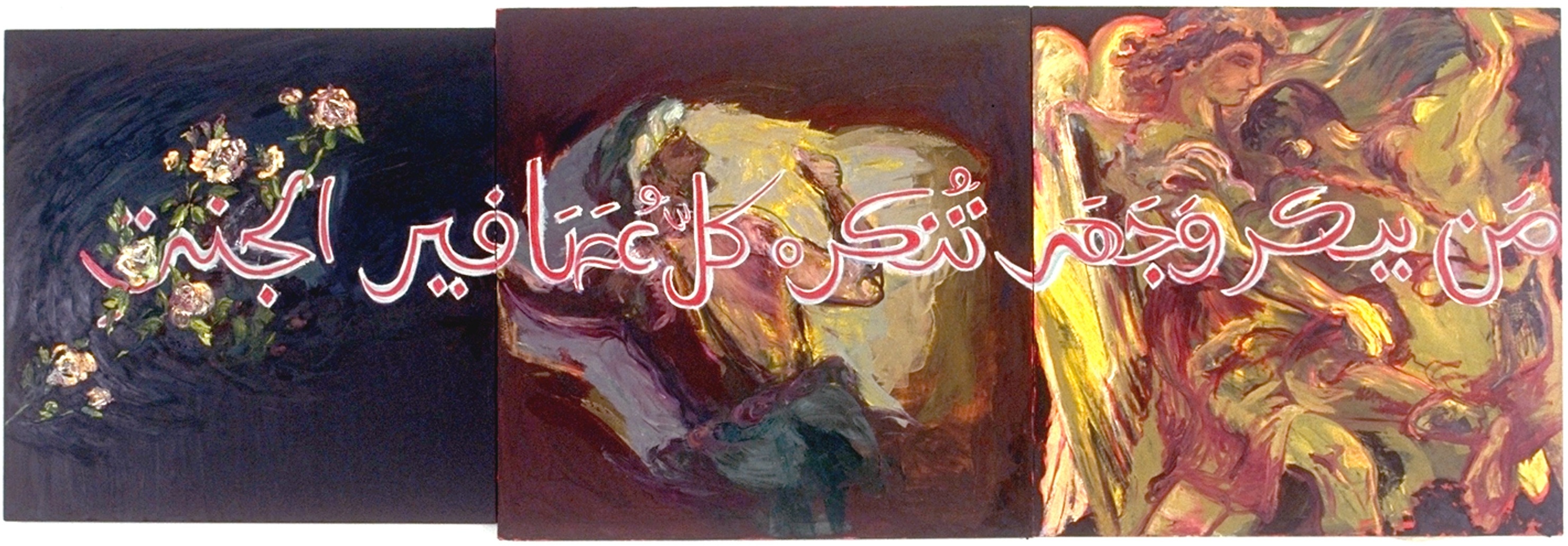 [Doris Bittar, "Watching Jacob 1" (1992). Image copyright the artist.]
[Doris Bittar, "Watching Jacob 1" (1992). Image copyright the artist.]
These grand paintings became a Sisyphean endeavor. Over a period of eight years three large-scale painting installations resulted on this subject. I may paint it one more time because I continue to be curious about it; what I can I extract from it now? Perhaps, the narrative would come of its own accord. How would “Watching Jacob 4” turn out if I had no conscious agenda? As a mature artist, I would go with the flow and enjoy it without as much anxiety.
As I created these paintings, I noticed that my obsession was an anxiety, and also becoming a significant factor in my thinking and raison d’être. I was standing back from myself and wondering why I cared so much. I created flanking panels in “Watching Jacob 2” as though they could act as quotations and make the Arab character central and more important as he gazed at Jacob. I felt it to be a ploy to “return the gaze,” which was a phrase much in fashion back then. There was a didactic directive to my repeated attempt at “correction.” It was humorous in some ways.
.jpg) [Doris Bittar, "Watching Jacob 2" (1994). Image copyright the artist.]
[Doris Bittar, "Watching Jacob 2" (1994). Image copyright the artist.]
I noticed that the quotation curtains in “Watching Jacob 2” looked like they could move over the narrative. I wondered what if they really could move? What would happen then? “Watching Jacob 3” was then created, and it was my first interactive piece. In this third attempt I could succeed if I shamelessly stacked the deck in the Arab’s favor. It was a competition against the blond angel.
“Watching Jacob 3” was dominated by a brown-burgundy moiré pattern, draping as valences. To address my evolving concerns this piece became changeable, a deconstruction of the narrative where I could cover up Jacob and the angel – just get rid of that scene if I wanted to. I depicted Jacob tiny and lost in the fabric small and the Arab much bigger. I did not flesh out the characters. Rather, I placed them within the moiré pattern as ghosts or layers that merged in and out of the pattern.
Three large joined paintings had tracks put on top, knobs were put on the sides of the moving paintings and it was ready to move. I came up with three or four positions for the moving patterns that I liked and I thought that the piece was complete. One day while randomly moving it, I noticed that the narrative was almost completely covered. It had, in fact, completely disappeared – even my Arab anti-hero. This story now had the ability to be silent. This painting was getting personal. It was mirroring my growing experience of alienation with the United States. I felt like I belonged nowhere from a daily diet of anti-Arab headlines. This theme of silence resulted after so many grand attempts to try to say something. It haunted me and continues to. I shifted a bit but continued to work with narrative aspects of Delacroix’s work, particularly his sketchbooks, which often depicted his Algerian translator’s family whom were Jewish.
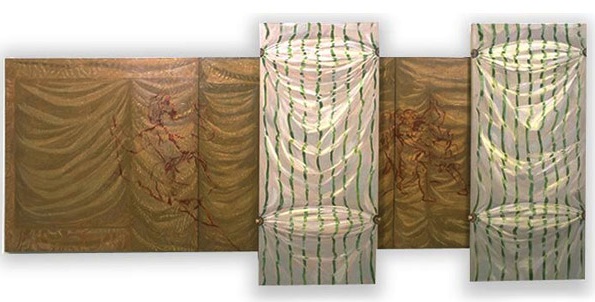
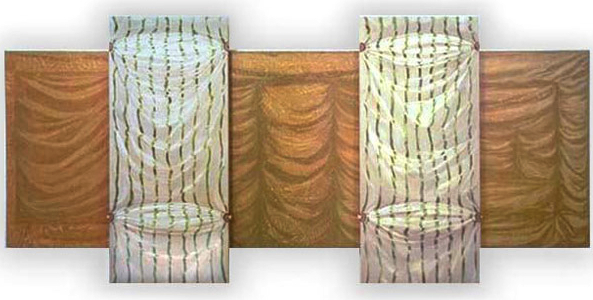 [Doris Bittar, "Watching Jacob 3" (1996). Demonstration of moving panels, which create variations of the painting. Image copyright the artist.]
[Doris Bittar, "Watching Jacob 3" (1996). Demonstration of moving panels, which create variations of the painting. Image copyright the artist.]
Why not look inward, at my own family history and dynamics within the context of the Lebanese Civil War? My absence, avoidance, and silence regarding my family narrative and the Lebanese Civil War moved to a central position in my thinking, but I wanted it to be personal. I wondered if there were clues, repressions and stress in family photos. Could these photos tell a story of the tragedy to come? The series “Lebanese Linen” emerged from slides– yes in a carousel – of photos my grandfather took that were put on a video by my uncle. These images, thrice removed, were dim and blurred. They were haunting traces of familiar faces and poses. This series was anchored in process, not research. Each day I began with a palette and a pattern. These began as abstract paintings that seemed to paint themselves. I was often in a trance while creating them. Despite their sherbet colors, I was going through an existential and painful depression. These paintings helped me work through it. I projected the slides onto to the patterned and thickly painted surfaces. The studio was dark and I really could not see what I was doing. My process was both random (intuitive) and specific (exacting). These paintings were completed within 24 – 48 hours, regardless of size.
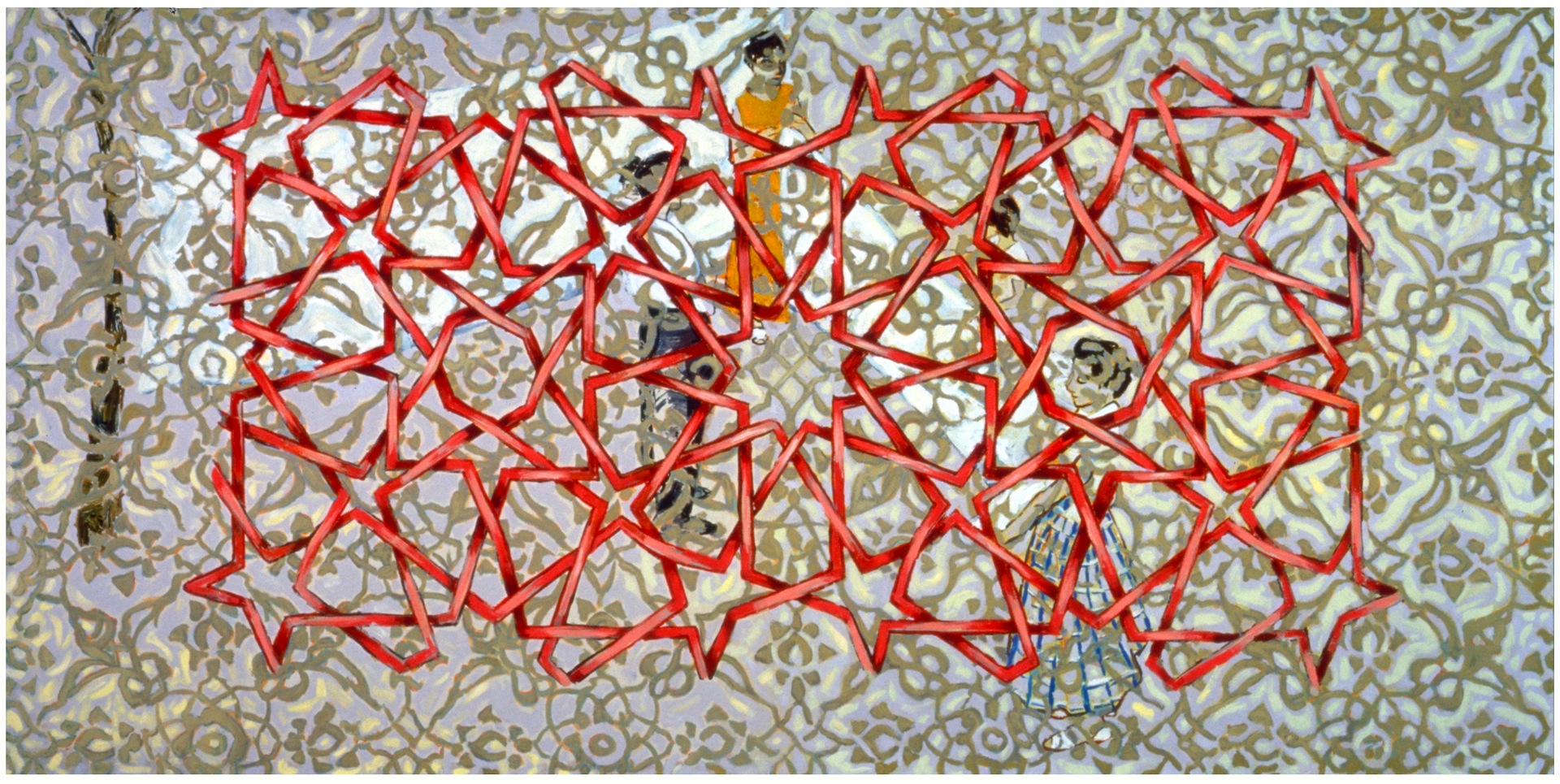 [Doris Bittar, "Folding Linens Araby" (1999). Image copyright the artist.]
[Doris Bittar, "Folding Linens Araby" (1999). Image copyright the artist.]
After 9-11, my alienation with the United States became more heightened like many Arab Americans. For a decade (until 2011), I painted at least a hundred paintings of the American flag with layers of Islamic and Middle Eastern patterns acting as filters and veils for the flag. I have a need that I recognized recently to find a way to feel like I belong in the United States, that I can contribute and be engaged with an intellectual community. I want to project a vision, not just be a sounding board for others to project onto or be reactive to the headlines. My alienation has grown, but I want to grow beyond that unsettling feeling. I moved on with new endeavors, such as my collaboration with poet Diane Gage and microtonal musician Jonathan Glasier. I found that I could not have done this work anywhere else but here in San Diego County. Since 2008, I have been showing internationally and I am frequently on Skype to stay in touch with artists who I have met at group exhibits and biennials. These artists and our conversations keep me vibrant. In fact, I decided to open a gallery in San Diego that shows these international artists, as well as regional artists that have been underrepresented. The art space is called Protea Gallery, after the South African flower that has adapted so well in Southern California. The flower–-yes, I sell it in my gallery--mirrors the artists who I will be showing. The protea flower, the word protean derived from Proteus, the Greek god who could change his shape at will, represent diversity, flexibility and courage.
“Thirteen OnLine,” my current collaboration with Madrid-based artist Noni Lazaga puts us both in the trenches. This has been the most intensely collaborative project I have been involved with. With “Tarab Soundings,” a pattern and music-making machine, I received technical help rather than design or conceptual input. “Tec Sayings” was more collaborative because poet, Diane Gage chose most of the words used. With Noni Lazaga it has been pure art-geek heaven where we frenetically handled each other’s work and brutally reworked it. Every piece we are proposing transforms our own work into something more specific and political. That surprised us last October 2012 when we worked doggedly within an exquisite corpse process for two days in Madrid. We created five sketches for installations that evoke the world’s economic struggles.
[The above post is part of Visuals in 1500, a new Jadaliyya Culture series on aesthetics.]